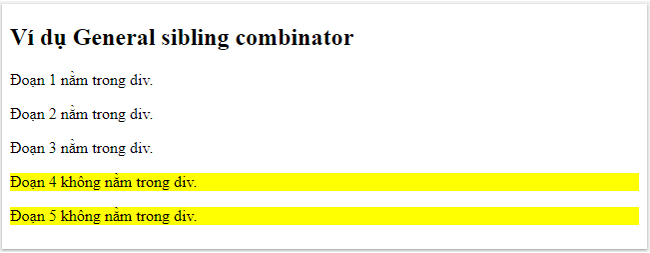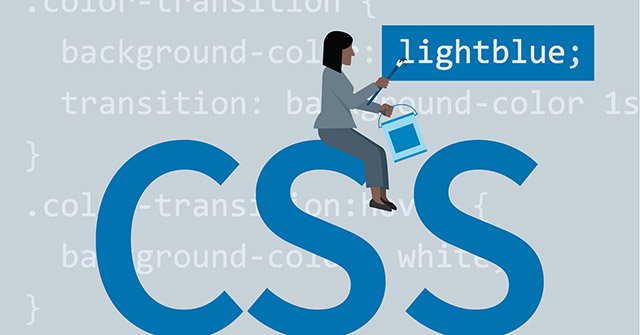Combinator in CSS
Combinator (combination) shows the relationship between selectors, allowing combining selectors together as characters.
In CSS, there are 4 familiar combinators as follows:
- Descendant combinator (space): Select elements that are descendants of another element.
- Child combinator (>): Select elements that are children of another element.
Note here that "descendants" are used to denote an element in another element, while "child" is the element directly located inside of another element. Eg
example
only span is the "child" of the div, and both span and p are "descendants" of the div.
- Adjacent sibling combinator (+): Select elements located adjacent and on par with other elements ("brother" elements are adjacent).
- General sibling combinator (~): Select element equal to another element ("brother" elements).
Descendant combinator
Descendant combinator (space) allows combining elements as descendants of another element.
div p {
background-color: yellow;
}
Here, descendants are p tags, the first element is div. The p tag in the div tag will have background-color: yellow.
For example:

Example Descendant combinator
Paragraph 1 is in the div.
Paragraph 2 is in the div.
Paragraph 3 is in the div.
Paragraph 4 is not in the div.
Paragraph 5 is not in the div.
Child combinator
Child combinator (>) allows combining "direct" sub-elements of another element (as explained above).
div > p {
background-color: yellow;
}
Here, the child element is p tag , the first element is div. The p tag in the div tag will have a background-color: yellow, and the other tags in p will not.
For example:

Example Descendant combinator
Paragraph 1 is in the div.
Paragraph 2 is in the div.
Paragraph 3 is in the div.
Paragraph 4 is not in the div.
Paragraph 5 is not in the div.
Adjacent sibling combinator
Adjacent sibling combinator (+) allows to select elements that are adjacent and on par with the specified element (adjacent "brother" elements).
div + p {
background-color: yellow;
}
Here, the element p is adjacent to and equal to the div, there will be background-color: yellow , and the other p tags in the div or p- cards are equal but not adjacent to the div .
For example:

Example Adjacent sibling combinator
Paragraph 1 is in the div.
Paragraph 2 is in the div.
Paragraph 3 is in the div.
Paragraph 4 is not in the div.
Paragraph 5 is not in the div.
General sibling combinator
General sibling combinator (~) allows to select elements that are equal to the specified element ("brother" elements).
div ~ p {
background-color: yellow;
}
Here, the element p is on the same level as the div will have background-color: yellow , and the other p tags in the div will not.
For example:

Example General sibling combinator
Paragraph 1 is in the div.
Paragraph 2 is in the div.
Paragraph 3 is in the div.
Paragraph 4 is not in the div.
Paragraph 5 is not in the div.
Previous post: Alignment - Align in CSS
Next lesson: Pseudo-class in CSS
You should read it
- 18 mistakes killing start-ups from founder Y Combinator (the last part)
- Dropbox Notes - group collaboration online notes service
- Attribute Selector - Attribute Selector in CSS
- Variable in PHP
- [General] What are the types of sinusitis?
- Syntax and Selector in CSS
- 3 main types of Linux distributions that you should know
- 2 types of foam should be skimmed, 3 types of foam should be kept when cooking
May be interested
- Pseudo-Class in CSS
 pseudo-class in css is used to add special effects to some selector.
pseudo-class in css is used to add special effects to some selector. - Pseudo-Element in CSS
 pseudo-element in css is used to add special formats to a selector
pseudo-element in css is used to add special formats to a selector - Opacity / Transparency property in CSS
 the opacity attribute determines the opacity and transparency of an element.
the opacity attribute determines the opacity and transparency of an element. - Navigation Bar - Navigation Bar in CSS
 navigation bar - navigation bar, or menu bar, is used to navigate the main sections of a website
navigation bar - navigation bar, or menu bar, is used to navigate the main sections of a website - Use Dropdown in CSS
 the dropdown effect is mainly used with navigation menus as an indispensable solution in website design, especially websites with a large number of indexes, cannot be arranged entirely on the interface.
the dropdown effect is mainly used with navigation menus as an indispensable solution in website design, especially websites with a large number of indexes, cannot be arranged entirely on the interface. - Image library in CSS
 css can be used to create collections that help you manage images in your website.
css can be used to create collections that help you manage images in your website.






 18 start-up killing mistakes from founder Y Combinator (part 1)
18 start-up killing mistakes from founder Y Combinator (part 1) 18 start-up mistakes from Y Combinator founder (part 2)
18 start-up mistakes from Y Combinator founder (part 2) 18 mistakes killing start-ups from founder Y Combinator (the last part)
18 mistakes killing start-ups from founder Y Combinator (the last part) Dropbox Notes - group collaboration online notes service
Dropbox Notes - group collaboration online notes service Can Pokemon Go be played on a computer? The answer is yes!
Can Pokemon Go be played on a computer? The answer is yes!